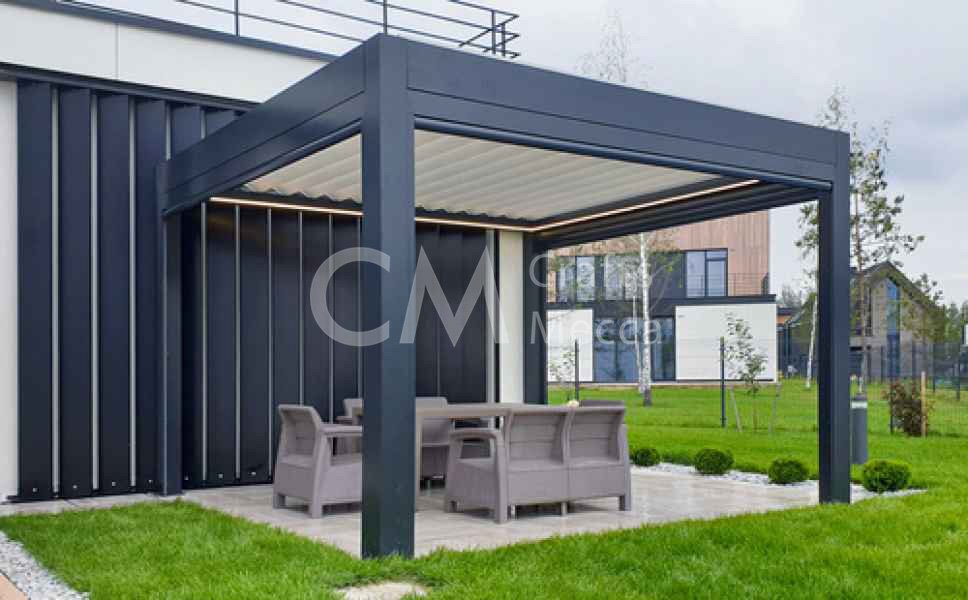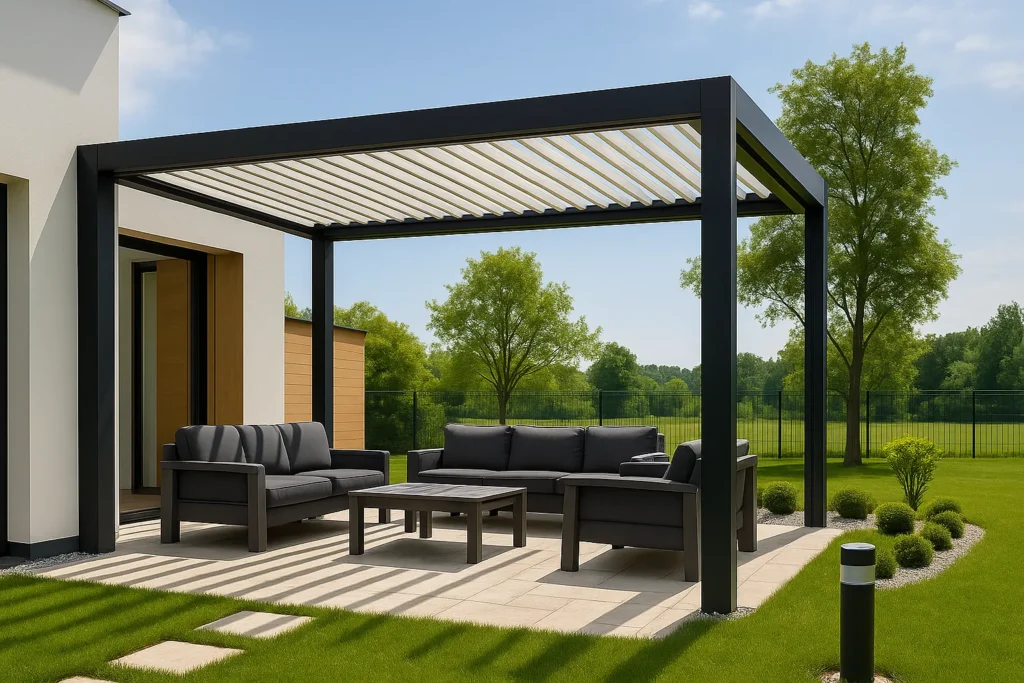A pergola is not only an aesthetic accent to your outdoor space, it is also a practical solution that creates shade, provides protection from the weather and makes everyday relaxation more comfortable. The most popular choices at the moment are bioclimatic and awning pergolas, which differ in design, functionality and adaptability. Which pergola is right for your home or business? Let’s take a look at the main differences.
1. Benefits and applications of pergolas in everyday life
The pergola is nowadays becoming a solution not only for aesthetics, but also for functionality. enriches the outdoor space in many ways. It provides shade on sunny days, protects against rain or wind, and allows you to enjoy the outdoors in almost all seasons. In the family backyard, a pergola can be transformed into cosy dining area, location for a quiet holiday or even a small green space corner with plants. In a business environment, it creates an attractive space for customers – in cafés, restaurants or hotels, it becomes an integral part of the image and a guarantee of comfort. Whether on large plots or in small courtyards a pergola helps you make the most of the available space and gives it added value. It’s a solution that adapts to a wide range of needs – from private homes to commercial projects. Every space more functionalityand the variety of pergola styles and types makes it possible to find the right option for both cosy courtyards and presentable business areas.
2. Bioclimatic pergolas: advantages, options and types
Bioclimatic pergolas are considered the top choice for their functionality and durability. Their roof slats can be rotatableto adjust light and air circulation, or floatingallowing the space to be fully exposed. Option 3 – PIR sandwich panelsfor those who want a permanent roof covering. All structures are designed to withstand rain, snow or strong winds, and an integrated rainwater harvesting system ensures a dry space in all conditions.
Installation options are also extensive: freestanding A free-standing pergola in the garden or backyard becomes a versatile seating area, wall-mounted pergola in front of a house or café provides a practical solution for a terrace, and a hanging The design is ideal for small spaces where additional columns are not desired. There are also integrated pergolas tailored to individual façade solutions.
Key benefits:
- Protection from sun, rain and even snow.
- Adjustable light and air flow.
- Durable construction made of strong materials (mostly aluminium).
- Modern design, adapted to contemporary architecture.
- Additional options: glass partitions, zip screen roller blinds, LED lighting.
Potential disadvantages:
- Higher price than awning pergolas.
- More difficult to install, requires a stable base.

3. Awning pergolas: a flexible and practical choice for your yard
Awning pergolas are lighter in weight, providing elegant shade and protection from sun and rain. Their roof is made of high quality PVC fabricwhich blocks UV rays and protects against precipitation. Such pergolas are mobile, as the structure can be easily mounted on different facades or freestanding in the yard.
Awning pergolas are divided into wall-mountedthose which are mounted on the building, free-standingideal for the garden or pool area, and hanging systemsto make the most of smaller spaces. The structure is often made of aluminium, which can be painted in a variety of colours to match different architectural styles. The biggest advantage is lower price and easy application, but compared to bioclimatic ones, they are less resistant to extreme weather conditions.
Key benefits:
- Lower cost, making them accessible to a wider range of users.
- Flexible adaptation – can be wall-mounted or freestanding.
- Easy installation and quicker customisation.
Potential disadvantages:
- Limited wind and moisture resistance.
- Shorter lifetime, especially with heavy use.
- Requires periodic maintenance, especially of the fabric part.
4. Bioclimatic or tarpaulin pergola: which to choose?
The most important thing to consider when choosing a pergola needs, budget and space specifics.
- If you’re looking for a year-round, intelligently controlled structure with maximum comfort – bioclimatic pergola will be your best choice. It is ideal for both private spaces and commercial facilities such as cafes or restaurants.
- If you want to a simpler and more cost-effective solutionthat provides shade and protection during the summer – it’s worth choosing an awning pergola. It is particularly suitable for seasonal use in courtyards, garden spaces or by the pool.
Feature | Bioclimatic pergola | Awning pergola |
Functionality | Year-round use, climate controlled | Mostly seasonal, with limited weather management |
Design | Modern, minimalist, durable | Lighter, simpler |
Durability | 15+ years, all weather resistant | 5-10 years, limited resistance |
Price | Higher investment (premium solution) | The economical choice |
Customization | Private spaces, restaurants, cafés, public areas | Home terraces, seasonal spaces |

Frequently Asked Questions (FAQs)
What is a bioclimatic pergola?
Bioclimatic pergola is a modern outdoor pergola with adjustable aluminium slats to control light, shade and air circulation. It offers durability and comfort in all seasons.
What are the advantages of a bioclimatic pergola?
Key benefits - automatic pergola roof control, weather resistance and elegant design. It is an investment in a long-lasting and high-quality outdoor space.
What is an awning?
The awning pergola is a lighter structure with a sturdy PVC awning that provides shade and protection from rain. It is most often chosen for its attractive pergola prices and easy installation.
What are the advantages and disadvantages of an awning pergola?
Benefits include lower cost, stylish design and easy installation. Disadvantages - limited resistance to severe weather conditions and reduced functionality compared to bioclimatic pergolas.
What are the main differences between a bioclimatic pergola and an awning?
Bioclimatic pergolas must adjustable slatsthat allow you to control sunlight, ventilation and rain protection. Meanwhile, awning pergolas are based on a fabric roof, which can be retractable or collapsible as required. The main difference is that bioclimatic tents offer more functionality and durability, while awning tents offer more flexibility and lower cost.
How much do pergolas cost and what drives the price differences?
Bioclimatic pergolas usually cost more due to their complex design, automated systems and durability. Awning pergolas cost lessbecause they are simpler in design and made of lighter materials. Price is also determined by size, choice of materials, complexity of installation and additional features such as LED lighting or automation.
Is a pergola only suitable for a terrace?
No, pergolas can be installed not only on terraces, but also in gardens, courtyards and even commercial spaces. The most popular choices are terrace pergola, free-standing pergola and wall pergola.
Which pergola is better for a small yard?
For smaller spaces, awning pergolas are the most common choice, as they can be adapted to different sizes of terraces or balconies. They are space-saving, visually lighter and provide sufficient shade. Bioclimatic pergolas are also possible in small backyards, but they are more suitable if you are looking for a long-lasting and luxurious solution.
Are pergolas high maintenance?
Bioclimatic pergolas are usually made of aluminium, so minimal maintenance - periodic surface washing is sufficient. Awning pergolas require a little more maintenance as the fabric can be affected by moisture or UV rays. Properly maintained both pergolas remain aesthetic and functional for many years.
Can a pergola increase the value of a house or business?
Yes, a pergola not only improves the aesthetics of an outdoor space but also increases its functionality. For homeowners, it provides an additional seating area, and for businesses, it provides a more attractive environment for customers. Such solutions often increase the value of the property and make the space more attractive for everyday use.
Conclusions
When choosing between a bioclimatic and an awning pergola, it is important to consider the conditions under which it will be used, the functionality you expect and the budget you are prepared to spend. Bioclimatic pergola – is a long-term investment in comfort and quality, while an awning pergola – a practical choice at an attractive price. In both cases, a pergola will make your backyard or terrace more cosy and aesthetically pleasing, and allow you to enjoy your outdoor spaces even more.
📞 Want to know which solution is right for your yard? Contact our team – we’ll help you realise your vision for your yard!

